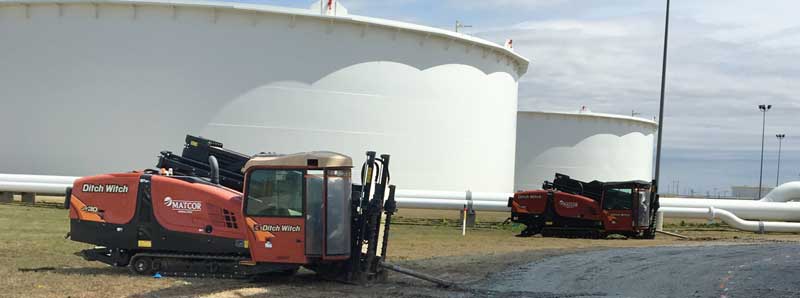
A client recently raised the concern about the cathodic protection reaction causing a drying out of the sand under a large diameter above ground storage tank. This is a very interesting question. We recently developed a stoichiometric analysis to assess the cathodic protection carbon footprint of a deep anode system by calculating the amount of carbon dioxide produced. The same methodology can be used to assess the risk of drying out of the tank bottom.
Assumptions
For this analysis, let’s assume a typical 150 ft diameter above ground storage tank with a bare tank bottom and a 1-foot sand bed resting atop a non-permeable liner. Based on a common design criteria of 2 mA/ft2 of bare surface area, this tank would nominally require a total of 17.7 amperes of current.
How much water does a cathodic protection system consume?
For every 2 electrons generated, one H2O molecule is required. One amp-year is equal to 3.1536 x 107 amp seconds or coulombs. One Faraday or 96.487 coulombs is equal to one mole of electrons therefore, one amp-year is equal to 326.84 moles of electrons. With the 2 to 1 ratio of electrons to H2O molecules that means that for every mole of electrons, 0.50 moles of H2O are generated. H2O has a molar mass of 18.0 g/mol so for each amp year a total mass of 2,941.6 grams of H2O is generated – that is approximately 0.78 gallons of water per amp year.
For our 17.7 ampere, 150 ft diameter tank anode system, that would mean 13.8 gallons of water is consumed as part of the cathodic protection reaction each year. Assuming that there is no new water being added into the tank foundation (a perfect chime seal and a completely non-permeable liner), then over a 30-year operating life the CP system would consume a little more than 400 gallons of water. While that might seem like a lot of water consumption, what is the percentage of drying out that is occurring with the sand over that time frame?
Will the Tank Bottom Dry Out?
Well, typical sand has a bulk density of approximately 100 lb/cubic foot and the typical moisture content for commercial sand is between 2% and 6%. For purposes of this exercise, let’s assume that the moisture content is on the low end at 2%. This means that there are approximately 2 lbs of sand per cubic foot. A 150 ft diameter tank has 17,671 cubic feet of sand bedding which equates to 35,342 lbs of water or about 4,241 gallons of water. So, if no new water is added over the thirty-year operating life, the typical CP system will consume about 10% of the sand moisture for very dry sand.
Conclusion
Given our assumptions and calculations, it does not appear that significant sand drying will occur due to water consumption.
Another Consideration: Electro-osmotic Drying
This analysis does not consider the effect known as electro-osmosis. Electro-osmotic drying is a process that is used in the civil engineering world to dewater sludges by creating a DC electrical flow – the flow of electrons pulls polar water molecules away from the anode. For CP applications, this is generally not considered to have a significant impact except where there are very high current densities at the anode – for example some deep anode systems operating at very high output rates in certain soil formations. For tanks, this is not considered an issue.
If you have other technical questions, or for information on MATCOR’s above ground storage tank cathodic protection solutions, please contact us at the link below.







Very interesting point of view. It will be great to support these calculations with the real data of the resistance of the CP circuit in function of service life. Of course, each case is different and specific to site conditions.
By the way, correct a typo in: “This means that there is approximately 2 lbs of sand per cubic foot of sand.”
Dear Antonio,
Thank you for visiting our site and for your comment on our posting. We have made the correction you pointed out…appreciate your bringing that to our attention.
Best regards,
MATCOR, Inc.